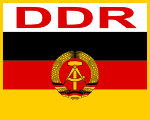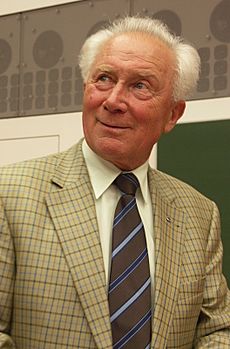Sigmund Jähn facts for kids
Quick facts for kids
Sigmund Jähn
|
|
|---|---|

Sigmund Jähn, 1978
|
|
| Born |
Sigmund Werner Paul Jähn
13 February 1937 |
| Died | 21 September 2019 (aged 82) |
| Nationality | German |
| Occupation | Pilot |
| Awards |
|
| Space career | |
 Interkosmos Cosmonaut |
|
| Rank | |
|
Time in space
|
7d 20h 49m |
| Selection | 1976 Intercosmos Group |
| Missions | Soyuz 31/Soyuz 29 |
|
Mission insignia
|
|
Sigmund Werner Paul Jähn (born February 13, 1937 – died September 21, 2019) was a German cosmonaut and pilot. In 1978, he made history by becoming the first German to fly into space. He was part of the Soviet Union's Interkosmos program, which allowed people from allied countries to join space missions.
Sigmund Jähn was born in a small town called Morgenröthe-Rautenkranz in Saxony, Germany. He was married and had two children. He spent his later years living in Strausberg, Germany, and passed away at the age of 82.
Contents
Sigmund Jähn: Germany's First Cosmonaut
Early Life and Military Career
Sigmund Jähn was born on February 13, 1937, in Morgenröthe-Rautenkranz, a town in the Vogtland region of Saxony, Germany. He went to school in his hometown from 1943 to 1951. After school, he trained to be a printer until 1954. He also helped run a program for young people in a local school.
In 1955, Sigmund Jähn joined the East German Air Force. There, he trained to become a pilot. He was a strong believer in socialism, a political and economic idea where the community owns and controls the means of production. From 1961 to 1963, he held a leadership role focused on political work. In 1965, he became responsible for air tactics and flight safety.
From 1966 to 1970, Jähn studied at the Gagarin Air Force Academy in Monino, which was in the Soviet Union. After his studies, he worked in the East German air force administration. He was in charge of training pilots and making sure flights were safe until 1976.
Journey to Space
On November 25, 1976, Sigmund Jähn was chosen for the Interkosmos program. This program allowed people from countries friendly with the Soviet Union to fly into space. He and his backup, Eberhard Köllner, spent a year training for their mission. They trained at Star City, a special facility near Moscow.
Jähn flew into space aboard the Soyuz 31 spacecraft. It launched on August 26, 1978. His destination was the Soviet space station Salyut 6. While in space, he performed many experiments. These included studying Earth from space, medical tests, biology experiments, and research on materials and geophysics.
After orbiting Earth 124 times, he returned to Earth on the Soyuz 29 spacecraft. He landed on September 3, 1978. Sigmund Jähn spent 7 days, 20 hours, and 49 minutes in space. In the Soviet space program, people who flew in space were called "cosmonauts," not "astronauts."
After his flight, the government of East Germany celebrated him. They called him "the first German in space." This was important because it showed an East German achievement over West Germany.
Life After Space
After his space mission, Sigmund Jähn led the East German Army's Cosmonaut Training Center. This center was located near Moscow. He continued in this role until Germany became one country again in 1990. At that time, he left the East German military as a major general.
On September 3, 1978, Jähn received the title of Hero of the Soviet Union. This was a very high honor. In 1983, he earned a doctorate degree. His studies focused on remote sensing of the Earth, which is about gathering information about Earth from a distance, like from space.
Sigmund Jähn also helped create the Association of Space Explorers. This group brings together people who have flown in space. He was a founding member in 1985 and served on its leadership team for several years.
After Germany reunited in 1990, Jähn worked as a consultant. He advised the German Aerospace Center and later the European Space Agency (ESA). He helped prepare for missions to the Mir space station. He retired from his work in 2002.
In 2011, on the 50th anniversary of the first human space flight by Yuri Gagarin, Jähn shared an interesting story. He explained that he took a toy figure called a Sandmännchen with him into space. This character was from an East German children's TV show. He planned to film material for the show. However, he and his fellow cosmonaut, Vladimir Kovalyonok, joked about the Sandmännchen marrying another toy figure. Because of this, the authorities decided the video was not suitable for the public.
Sigmund Jähn enjoyed reading and hunting in his free time. He passed away on September 21, 2019, at the age of 82.
Awards and Honors
Sigmund Jähn received many important awards for his achievements.
- Meritorious Military Pilot of the German Democratic Republic
 Hero of the German Democratic Republic
Hero of the German Democratic Republic Hero of the Soviet Union
Hero of the Soviet Union- Order of Karl Marx
- Order of Lenin
- Fliegerkosmonaut der Deutschen Demokratischen Republik (He was the only person to receive this award.)
In 2001, an asteroid was named "Sigmundjähn" in his honor. In 2011, he became an honorary member of the Leibniz Society of Berlin.
What People Said
Sigmund Jähn shared his feelings about his space flight and what he saw:
- "Dear TV viewers in the German Democratic Republic. I am very happy for the chance to be the first German to take part in this manned space flight." (during his space flight)
- "…what I saw then was total happiness: Our Earth, shining in bright blue. Just like a dream." (from an interview in 1998)
- "As a pilot I just could not resist the offer to fly a space capsule…" (from a speech in 2005)
How He Influenced Culture
Sigmund Jähn's journey inspired many people.
- Schools, preschools, and even ships were named after him.
- In the 2003 German film Good Bye, Lenin!, Sigmund Jähn is the hero of the main character, Alex Kerner. Alex tries to hide from his mother that the Berlin Wall fell while she was in a coma. He finds a taxi driver who looks like Jähn. This taxi driver pretends to be "Comrade Jähn" in a fake news report. In the report, he says he will open the East German borders. This is to make his mother believe that East Germany is still a country.
- The German pop group Die Prinzen wrote a song called "Wer ist Sigmund Jähn?" ("Who is Sigmund Jähn?"). It was on their 1999 album So viel Spaß für wenig Geld.
Images for kids
See also
 In Spanish: Sigmund Jähn para niños
In Spanish: Sigmund Jähn para niños




